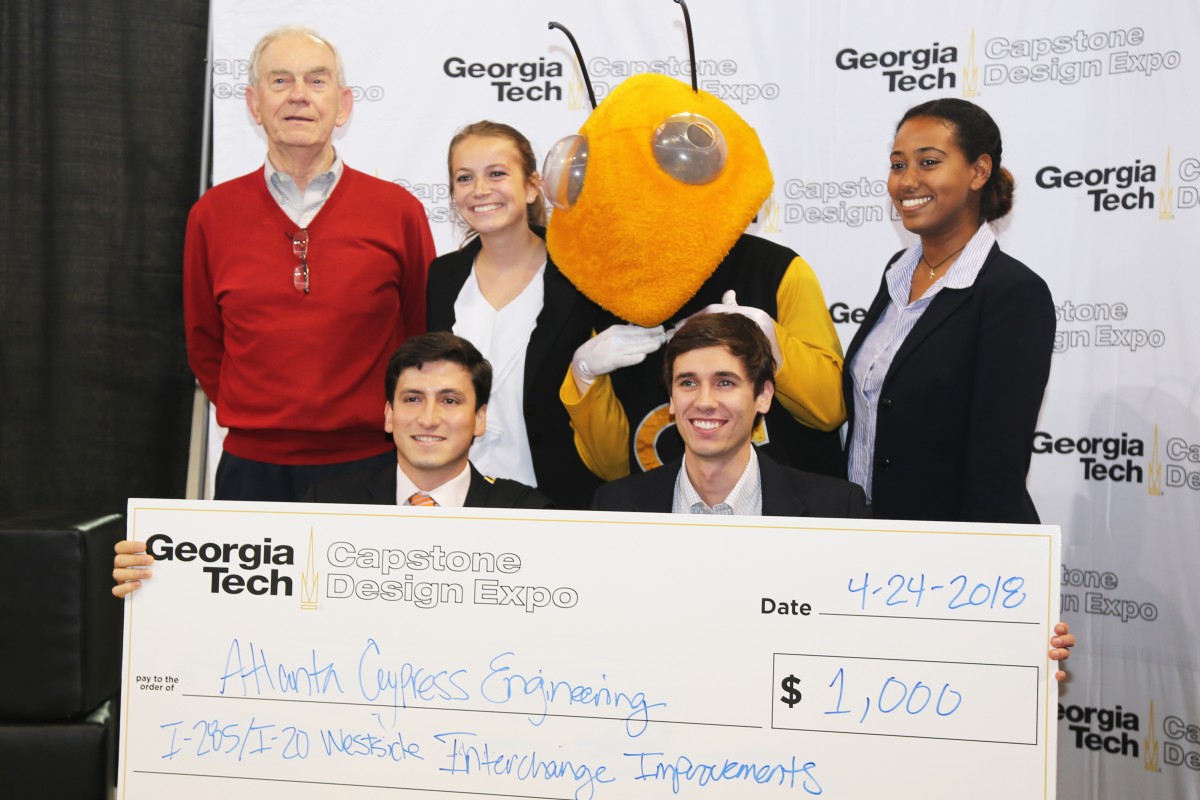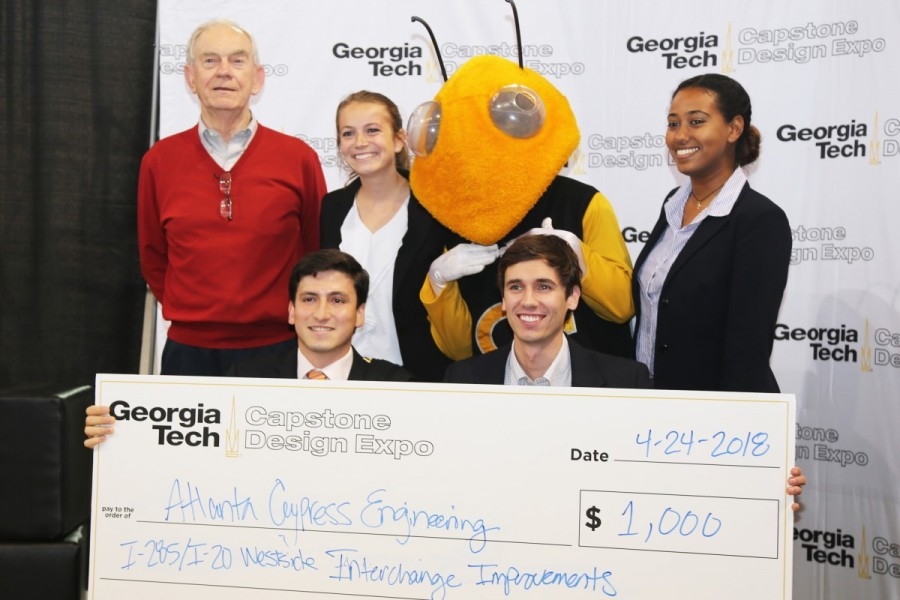 Atlanta Cypress Engineering won the civil and environmental engineering award at the spring 2018 Capstone Design Expo. Their project proposed some simple changes to the junction of Interstates 285 and 20 on Atlanta's Westside to improve traffic flow, potentially saving drivers a year's worth of commute time every afternoon. They were one of 13 teams from the School who presented their senior design projects at the expo this semester. The team poses with the winning check. From right: Blane Solomon, Andrew Pofahl, Buzz, Alex Hare, and Ramiro Santana along with senior design professor John Koon. (Photo: Jess Hunt-Ralston) |
A simple design change with the potential of saving Atlanta drivers a combined year’s worth of travel time every day took home the civil and environmental engineering top prize at the Georgia Tech Capstone Design Expo April 24.
The Georgia Department of Transportation tasked Team Atlanta Cypress Engineering with improving the interchange at I-20 and I-285 on Atlanta’s Westside for the next few years as the department ramps up for a complete rebuild of the junction. The team’s solution was deceptively simple: restripe the lanes from 285 to westbound I-20 to eliminate merges responsible for bottlenecks that can stretch for miles.
Simulations of the change showed staggering improvement, said civil engineering senior Andrew Pofahl.
“We looked at traffic volumes five years from now in 2023, we threw them into this model with a bunch of other data from GDOT,” Pofahl said, “and what we found is the movement from 285 coming south to I-20 westbound, you save 10 1/2 minutes. Just going through the interchange. In less than a mile, you save 10 1/2 minutes. And then from 285 north to 20 west, it’s almost 7 1/2 minutes.”
With weekday afternoon volumes around 50,000 vehicles, the savings add up quickly. And they ripple out from the interchange, improving traffic flow even miles away.
“Changes [at the intersection] vastly improve the whole network,” said Ramiro Santana. The project was one of their top choices, he said, because “we realized, if we worked on a project like this, we could really make a change.”
The team’s modeling also takes into account traffic growth around the interchange leading up to the rebuild in 2023, and the fix still works, said Alex Hare.
“We wouldn’t want to make a project that fixes stuff today but five years from now is completely irrelevant,” she said. “It fixes what we wanted to focus on and really makes a difference in this location.”
The team was one of 13 civil and environmental engineering groups presenting their senior design projects at the spring expo. Projects included site designs, wastewater treatment projects, multi-use trail designs for the PATH Foundation, and other transportation redesigns.
Team MAKT Engineering did preliminary geotechnical engineering work for a possible third phase of Tech Square in Midtown Atlanta. If Tech one day decided to build another high-rise, mixed-use project near the under-construction Coda building, could they put in an underground parking structure?
Sounds like a straightforward problem, but the team found quickly that underground rock and a relatively high groundwater level creates challenges. That made it an interesting project, said team member Madison Thrift, an environmental engineering senior.
“We thought it was the most diverse project. There’s so much that goes into it,” Thrift said. “Yes, it’s a subsurface parking deck, but not all that goes into it is building a parking deck. We got a little structural [engineering], a little geotech, traffic, groundwater.”
Team Blue Ridge Consulting had to design a wastewater treatment facility for a beverage bottling plant, ensuring that water discharged into College Park’s water system meets city regulations. Mihika Ram said the process crystallized for her what it’s like to work with a client and adapt your design to meet their needs.
“We had a lot of conflicting opinions between our professor and our client, so balancing the two and realizing it’s really what that client wants is more important and we’ll bend our process to meet that — I think that was a valuable lesson,” she said. “Whatever our client, Prime Engineering, wants, we’re going to have to make that happen.”

